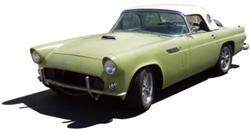|
Author
|
Message
|
|
peeeot
|
|
|
Group: Forum Members
Last Active: Last Year
Posts: 357,
Visits: 25.5K
|
I've been looking around the Internet on this subject and turned up nothing other than descriptions of how Load-O-Matic works and how to replace it with a conventional dual-advance distributor. It seems to me that a Loadomatic could be tuned and optimized in much the same way as a dual-advance, by installing lighter springs and calibrating the vacuum can to give maximum advance at different speeds and loads without pinging. I understand that a vacuum-controlled advance mechanism makes little sense for a drag car, but I don't see a reason why Loadomatic couldn't be tweaked to provide snappier response and an optimized curve for a street car. Am I wrong, or is there some other reason no one has bothered to write anything about optimizing the loadomatic?
1954 Crestline Victoria 312 4-bbl, 3-speed overdrive
|
|
|
|
|
paul2748
|
|
|
Group: Forum Members
Last Active: Yesterday
Posts: 3.7K,
Visits: 497.8K
|
While I'm no distributor expert, I suspect you are right. These distributors worked on cars built from 1949 to 56 and ran okay with them.
54 Victoria 312; 48 Ford Conv 302, 56 Bird 312
Forever Ford
Midland Park, NJ
|
|
|
|
|
oldcarmark
|
|
|
Group: Forum Members
Last Active: 8 days ago
Posts: 3.7K,
Visits: 32.6K
|
The advantage of the later style Distributor is that it is much more responsive to both Engine Vacuum (low speed and load) and Speed (Centrifugal). In 1957 Ford changed both the Carburetor to the new Holley and the dual Advance Distributor. Just my Opinion but unless You are building a 100 Point Restoration changing the Distributor to the later Style is a worthwhile upgrade. Much more "tune-able" than the Loadomatic. I changed the Distributor on mine before I changed the Carburetor and just that simple upgrade made a big difference even retaining the Teapot. When I changed the Carburetor it was like driving a different Car.
 
|
|
|
|
|
PF Arcand
|
|
|
Group: Forum Members
Last Active: Last Year
Posts: 3.3K,
Visits: 238.8K
|
The Load-O-Matic distributor principal was a carry over from the Flat Head days. Neither G.M. or Chrysler used that type of system as Ford did in 1954(U.S.)'55 & '56. I'm not an expert on the subject, but according to Jerry Christenson, who writes in Y-Block Magazine regularly, it was possibly the worst performance related mistake that Ford made in that period.
Paul
|
|
|
|
|
oldcarmark
|
|
|
Group: Forum Members
Last Active: 8 days ago
Posts: 3.7K,
Visits: 32.6K
|
1956 was not the end of the Load-o-matic Distributor. Ford continued to use it on the 6 Cylinder Engines through the 1960's.
 
|
|
|
|
|
GREENBIRD56
|
|
|
Group: Forum Members
Last Active: Last Year
Posts: 1.7K,
Visits: 102.7K
|
I believe a lack of reliable "operating information" is what defeats the Load-O-Matic advance system. The operating scheme is to monitor engine speed by means of venturi vacuum - basically sampling the "air speed" at the carburetor throat. While the reaction of the distributor to this venturi vacuum signal can be optimized - the orifices, passageways, and so on don't stay in good condition for long periods. As that vacuum system declines in efficiency (is less effective at predicting rpm) - the engine spark gets steadily more retarded. Tends to heat the engine up - and lack in performance. While the system can - in good condition - predict engine rpm, it is not sensitive to load. At a given rpm, air flow through the venturi is one thing - but manifold vacuum is another...... Ford changed the system near the end of its use (on the V8's) to have a second vacuum diaphragm piggybacked on the venturi set-up - the second diaphragm monitoring manifold vacuum. In practice, it tends to be a fixed offset - adding advance when the manifold vacuum is high - and subtracting it when the vacuum is low. In that manner the second pot tends to be somewhat like the vacuum pot on the post '57 systems - detects high engine load - and reduces the spark advance.

Steve Metzger Tucson, Arizona
|
|
|
|
|
DANIEL TINDER
|
|
|
Group: Forum Members
Last Active: Yesterday
Posts: 1.7K,
Visits: 154.2K
|
peeeot (6/19/2016)
I've been looking around the Internet on this subject and turned up nothing other than descriptions of how Load-O-Matic works and how to replace it with a conventional dual-advance distributor. It seems to me that a Loadomatic could be tuned and optimized in much the same way as a dual-advance, by installing lighter springs and calibrating the vacuum can to give maximum advance at different speeds and loads without pinging. I understand that a vacuum-controlled advance mechanism makes little sense for a drag car, but I don't see a reason why Loadomatic couldn't be tweaked to provide snappier response and an optimized curve for a street car. Am I wrong, or is there some other reason no one has bothered to write anything about optimizing the loadomatic? It can be done, but takes a Sun distributor machine and some specialized hardware (plus yankee ingenuity). I have a dual point kit in my original 6V Load-O-Matic and an extremely responsive, hot-rodded Pony teapot. I converted an adjustable aftermarket advance stop device from the 50s to limit advance after adjusting the springs to bring advance in quicker (imitating the more desirable centrifugal performance curve). My sun machine also has a very accurate manometer, needed since the teapot vacuum signal is so weak. While I WOULD likely install a Mallory tack-drive if I ever get an aluminum manifold & newer carb., for now I have never felt the need since I am quite happy with the cars performance.
6 VOLTS/POS. GRD. NW INDIANA
|
|
|
|
|
peeeot
|
|
|
Group: Forum Members
Last Active: Last Year
Posts: 357,
Visits: 25.5K
|
Daniel, I'm glad to hear that at least someone has been able to tune some more responsiveness into a Loadomatic. With the Sun machine you can know exactly how you have set the curve based on vacuum input, but how did you determine what the curve should look like? Did you drive extensively with a vacuum gauge T-ed into the carb-to-distributor line to determine what the vacuum signal actually was under various circumstances?
In the absence of a Sun machine, my thinking has been to try reducing spring load, either by turning the eccentrics or swapping in a lighter spring, to give more advance per unit vacuum applied, and road testing to see whether performance improves and whether there is any pinging. I'm not trying to build a hot rod, just want the most I can get from what I have (stock).
1954 Crestline Victoria 312 4-bbl, 3-speed overdrive
|
|
|
|
|
DANIEL TINDER
|
|
|
Group: Forum Members
Last Active: Yesterday
Posts: 1.7K,
Visits: 154.2K
|
I have collected a lot of info from old speed/car magazines, so was able to find an appropriate/suggested curve to copy. Drove around with a simple T'd-in vacuum gauge to get a rough idea of what happens on the road, but not much help as the signal is so weak (my ultra-accurate Sun machine-mounted manometer is really not mobile). I DID buy some other Sun instruments that should make better road tuning possible, but just never got around to dealing with it all.
You can play with the eccentrics and juggle various spring types to get really precise, but the important factor is a mechanical stop device of some kind, since weakening the springs will always lead to excessive advance & likely engine damage/pinging. I think the 50s part I converted was initially sold by Edelbrock. It had it's own adjustable main spring, and was designed to allow total removal of both Load-O-Matic springs, and it screwed into where the vac. line plumbs in. I think the OEM dual springs allow better curve flexibility, so I just removed the big aftermarket spring, and once the proper limit position was found I glued it in place, connected it to the vac. line, and sealed it air-tight with silicon.
In retrospect, it was a lot of damn trouble to go to just to prove a point, and I likely would (like everyone else does) now just recommend getting a later centrifugal distributor pre-curved by a pro shop and get on with driving. 50s era dual-point kits usually need custom fitting, aftermarket Load-O-Matic parts are now nearly impossible to find (just like good working Sun machines & people who know how to use, maintain & calibrate them).
6 VOLTS/POS. GRD. NW INDIANA
|
|
|
|
|
aussiebill
|
|
|
Group: Forum Members
Last Active: 5 Years Ago
Posts: 1.8K,
Visits: 11.4K
|
Good to hear from Daniel who has good info on these distributors, he would know you can adjust the spring rate by rotateing the mounting posts.
 AussieBill YYYY Forever Y Block YYYY AussieBill YYYY Forever Y Block YYYY Down Under, Australia
|
|
|
|